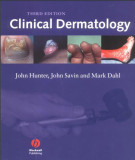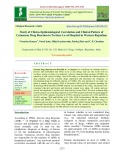
Drug eruptions
-
Part 2 book Dermatology - An illustrated colour text" includes content: Disorders of nails; vascular and lymphatic diseases; urticaria and angioedema, blistering disorders, connective tissue diseases, vasculitis and the reactive erythemas; Skin changes in internal conditions, drug eruptions, associations with malignancy, neurocutaneous disorders and other syndromes.
 145p
145p  zizaybay1101
zizaybay1101
 30-04-2024
30-04-2024
 3
3
 2
2
 Download
Download
-
Methotrexate is an anticancer drug from the antimetabolite class. It is also used in gynecology and obstetrics and is the molecule of choice for the medical treatment of ectopic pregnancies. We report a case of toxidermia associated with severe pancytopenia induced by methotrexate for ectopic pregnancy.
 5p
5p  vilazada
vilazada
 31-01-2024
31-01-2024
 3
3
 2
2
 Download
Download
-
Part 2 book "Clinical dermatology" includes content: Infections, infestations, skin reactions to light, disorders of pigmentation, skin tumours, the skin in systemic disease, the skin and the psyche, other genetic disorders, drug eruptions, medical treatment, physical forms of treatment.
 178p
178p  muasambanhan05
muasambanhan05
 16-01-2024
16-01-2024
 1
1
 0
0
 Download
Download
-
Adverse drug reactions are described as “A response to a medicine in a human which is noxious and unintended and which occur at any dosage and can also result from an overdose, misuse or abuse of a medicine. Adverse cutaneous drug reactions (ACDRs) are caused by a wide variety of drugs. Aim of the study is to determine the clinical patterns of drug eruptions and the common drugs implicated and determine the frequency of incriminating drugs for different patterns of CADRs.
 10p
10p  nguaconbaynhay7
nguaconbaynhay7
 15-08-2020
15-08-2020
 19
19
 1
1
 Download
Download
-
(bq) part 2 book "dermatology for advanced practice clinicians" presentation of content: superficial fungal infections, disorders of hair and nails, vasculitis and hypersensitivity, cutaneous drug eruptions, pigmentation and light related-dermatoses, genital dermatoses, wound care,... and other contents.
 226p
226p  thangnamvoiva23
thangnamvoiva23
 06-10-2016
06-10-2016
 49
49
 6
6
 Download
Download
-
(BQ) Continued part 1, part 2 of the document Illustrated manual of pediatric dermatology - Diagnosis and management presents the following contents: Photodermatoses and physical injury and abuse, drug eruptions, pigmentary disorders, collagen vascular diseases, vascular and lymphatic diseases, hair disorders, nail disorders, genodermatoses and syndromes,...
 223p
223p  thangnamvoiva5
thangnamvoiva5
 14-07-2016
14-07-2016
 44
44
 1
1
 Download
Download
-
(bq) nearly two decades after the first drug eruptions & reactions manual was compiled by dr. litt, this classic work has been developed and expanded into litt’s d.e.r.m. relied upon by dermatologists and medical practitioners internationally for its unparalleled practical focus on adverse effects and cutaneous reactions, this text is the essential quick-reference tool for patient care and drug safety.
 77p
77p  thangnamvoiva5
thangnamvoiva5
 14-07-2016
14-07-2016
 46
46
 2
2
 Download
Download
-
(bq) part 2 book "litt's drug eruption reference manual including drug interactions" presents the following contents: drugs responsible for common reaction patterns, drugs responsible for common reaction patterns, alphabetical index of drug eruptions a–z
 717p
717p  thangnamvoiva5
thangnamvoiva5
 14-07-2016
14-07-2016
 24
24
 2
2
 Download
Download
-
(bq) part 2 book "requisites in dermatology - pediatric dermatology" presents the following contents: drug eruptions and inflammatory eruptions of the skin; pigmentary disorders - white spots, brown spots and other dyschromias, lumps and bumps, skin conditions in newborns and infants, genetic disorders of the skin, disorders of hair and nails, the skin in systemic disease
 113p
113p  thangnamvoiva5
thangnamvoiva5
 14-07-2016
14-07-2016
 36
36
 1
1
 Download
Download
-
Tuyển tập báo cáo các nghiên cứu khoa học quốc tế ngành y học dành cho các bạn tham khảo đề tài: Fixed drug eruption resulting from fluconazole use: a case report
 4p
4p  thulanh30
thulanh30
 19-12-2011
19-12-2011
 43
43
 2
2
 Download
Download
-
Tuyển tập các báo cáo nghiên cứu về y học được đăng trên tạp chí y học General Psychiatry cung cấp cho các bạn kiến thức về ngành y đề tài: Patch Testing in Non-Immediate Drug Eruptions...
 9p
9p  thulanh10
thulanh10
 09-10-2011
09-10-2011
 43
43
 3
3
 Download
Download
-
Dịch tễ học Tần số: Trong các bệnh nhân dị ứng thuốc, hồng ban nhiễm sắc cố định chiếm khoảng 2-5% bệnh nhân điều trị nội trú, trên 1% bệnh nhân điều trị ngoại trú. Các nghiên cứu cho thấy, bệnh đứng hàng thứ hai hoặc thứ ba trong các phản ứng phụ của thuốc ở da. Chủng tộc: không có sự ưu thế về chủng tộc. Giới: tỷ lệ nam/nữ khoảng 1/1,1. Tuổi: bệnh nhân trẻ tuổi nhất là 1,5; bệnh nhân già nhất là 87. Nguyên nhân: kháng sinh, thuốc chống động kinh, NSAIDs,... Đường dùng: uống, đặt,...
 4p
4p  thanhongan
thanhongan
 14-12-2010
14-12-2010
 363
363
 7
7
 Download
Download
-
Các hội chứng phát ban phồng nước hoặc bóng nước gây ra do thuốc, phản ứng phản vệ liên quan đến thuốc, tăng nhạy cảm với thuốc là những thể nặng trong các phản ứng phụ của thuốc. Các phát ban bóng nước do thuốc có thể phân loại thành các bệnh cảnh sau: -Dạng xốp hóa (spongiotic) hoặc dạng chàm (eczematous), -Ngoại ban mụn mủ toàn thân cấp tính (acute generalized exanthematous pustulosis), -Phát ban do thuốc cố định (fixed drug eruption), -Hồng ban đa dạng (erythema multiforme), hội chứng Stevens-Johnson, ly thượng bì hoại tử nhiễm độc (toxic epidermal...
 5p
5p  thanhongan
thanhongan
 14-12-2010
14-12-2010
 159
159
 13
13
 Download
Download
-
Sulfonamides Antibacterial sulfonamides have a rather high risk of causing cutaneous eruptions and are among the drugs most frequently implicated in SJS and TEN. The combination of sulfamethoxazole and trimethoprim frequently induces adverse cutaneous reactions in patients with AIDS (Chap. 182). Desensitization is often successful in AIDS patients with morbilliform eruptions but is not recommended in AIDS patients who manifested erythroderma or a bullous reaction in response to their earlier sulfonamide exposure.
 5p
5p  konheokonmummim
konheokonmummim
 03-12-2010
03-12-2010
 70
70
 3
3
 Download
Download
-
Allopurinol Together with sulfonamides and antiepileptics, allopurinol is one of the "usual suspects" that induce frequently mild maculopapular eruptions (in at least 3% of users) and may also cause more severe reactions including hypersensitivity/DRESS and SJS/TEN. Because of increasing utilization it is one of the most frequent causes of life-threatening reactions. Anti-HIV Medications In clinical trials, combinations of highly active antiretroviral treatments were frequently associated with ≥10% "drug eruptions.
 5p
5p  konheokonmummim
konheokonmummim
 03-12-2010
03-12-2010
 72
72
 3
3
 Download
Download
-
These reactions are characterized by one or more sharply demarcated, erythematous lesions, sometimes leading to a blister. Hyperpigmentation results after resolution of the acute inflammation. With rechallenge, the lesion recurs in the same (i.e., fixed) location. Lesions often involve the lips, hands, legs, face, genitalia, and oral mucosa and cause a burning sensation. Most patients have multiple lesions. Fixed drug eruptions have been associated with phenolphthalein, sulfonamides, cyclines, dipyrone, NSAIDs, and barbiturates.
 5p
5p  konheokonmummim
konheokonmummim
 03-12-2010
03-12-2010
 66
66
 3
3
 Download
Download
-
Delayed hypersensitivity mechanisms directed by drug-specific T cells are probably the most important mechanisms in the etiology of the most common drug eruptions—morbilliform exanthems—and also of rare and severe forms such as hypersensitivity syndrome, acute generalized exanthematous pustulosis (AGEP), Stevens-Johnson syndrome (SJS), and toxic epidermal necrolysis (TEN). Drugspecific T cells have been detected in these types of drug eruptions. Contrary to what has been believed for years, the antigen is more often the native drug itself than its metabolites.
 5p
5p  konheokonmummim
konheokonmummim
 03-12-2010
03-12-2010
 82
82
 5
5
 Download
Download
-
Also systemic. f In adults, associated with renal failure and immunocompromised state. Vesicles and bullae are also seen in contact dermatitis, both allergic and irritant forms (Chap. 53). When there is a linear arrangement of vesicular lesions, an exogenous cause should be suspected. Bullous disease secondary to the ingestion of drugs can take one of several forms, including phototoxic eruptions, isolated bullae, Stevens-Johnson syndrome (SJS), and toxic epidermal necrolysis (TEN) (Chap. 56).
 4p
4p  konheokonmummim
konheokonmummim
 30-11-2010
30-11-2010
 81
81
 4
4
 Download
Download
-
Drug-induced erythroderma (exfoliative dermatitis) may begin as an exanthematous (morbilliform) eruption (Chap. 56) or may arise as diffuse erythema. A number of drugs can produce an erythroderma, including penicillins, sulfonamides, carbamazepine, phenytoin, gold, allopurinol, and zalcitabine. Fever and peripheral eosinophilia often accompany the eruption, and there may also be facial swelling, hepatitis, and allergic interstitial nephritis; this constellation is frequently referred to as drug reaction with eosinophilia and systemic symptoms (DRESS).
 5p
5p  konheokonmummim
konheokonmummim
 30-11-2010
30-11-2010
 60
60
 5
5
 Download
Download
CHỦ ĐỀ BẠN MUỐN TÌM































